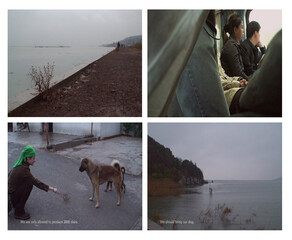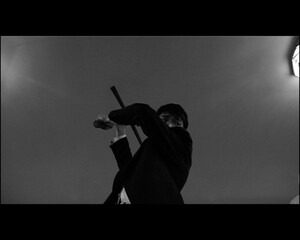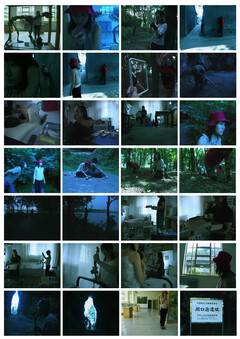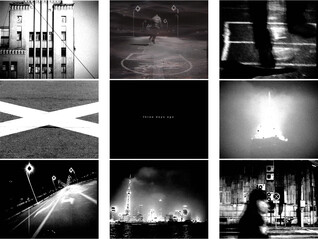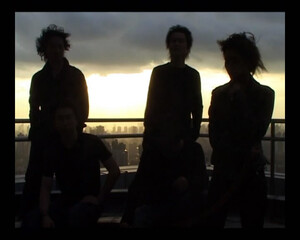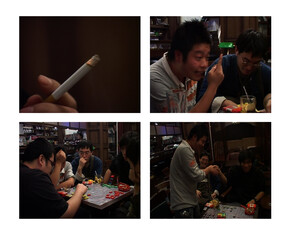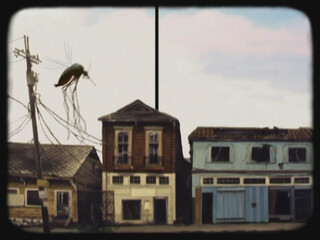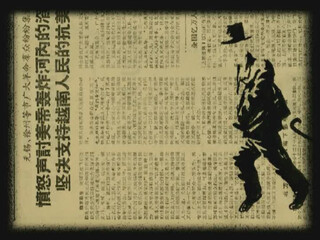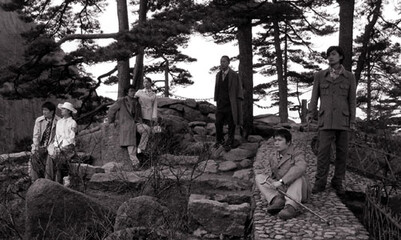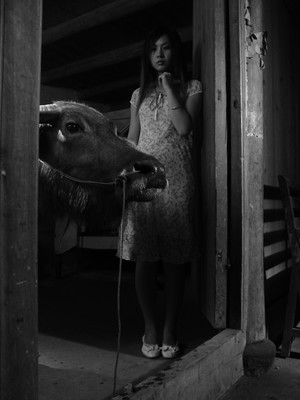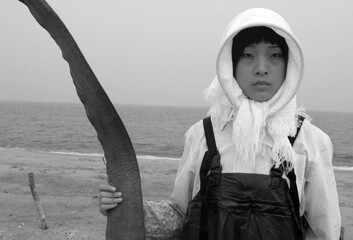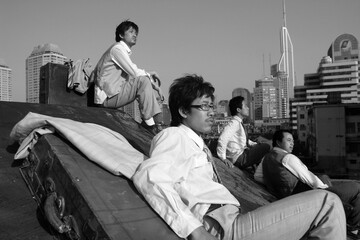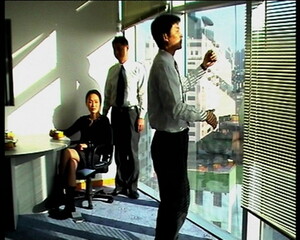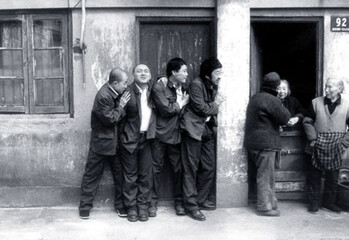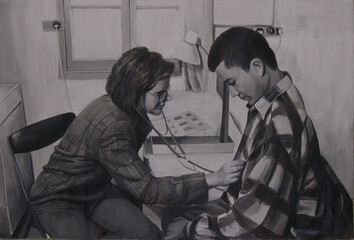Group Exhibition Kunsthalle Bern, Switzerland
Works Intro:
Chen Xiaoyun: Queen Lili’s Garden
2004, 74’
With his video works and large-scale photographs, Chen Xiaoyun examines the relationship between the individual and society in China’s rapidly changing cultural climate. His works emphasize the artist’s role in searching for possible ways in which the individual can escape, often using strong, apparently meaningless and anarchic gestures to illustrate the human individual within its environment. Queen Lili’s Garden is a film about love, loneliness and one’s innermost feelings in a strange world. An anonymous character is followed, narrated with subtitles only.
Liang Yue: Travelling Day
2006, 19’ 30”
Travelling Day is played out as a documentary movie among a vast group of friends. The group travels from Shanghai to a beach for some leisure time. We witness the young people fooling round, playing with some dogs, drinking beer, and throwing stones into the water. It’s a subtle portrait of everyday things in the life of ordinary young people.
Lu Chunsheng: Trotzky murdered in Summer, Gentlemen in Financial Circles got more Depressed
2003, 22’
In Trotsky Murdered in Summer, Gentlemen in Financial Circles Got More Depressed, scenes of a modern-day corporate environment are cut with the enactment of a murder. Not following the actual circumstance of Trotsky's death, the scenes played out by the costumed young men are something more like a sketchily remembered idea. While the bulk of the action is in black and white, a color sequence follows in a more obviously contemporary setting; the young men walk through the streets raging and shouting. Little is resolved, and the viewer is left with the sense that they are as perplexed by the slipperiness of collective memory as they are by the murder.
Lu Chunsheng, History of Chemistry
2004, 29’
History of Chemistry 2: Excessively Restrained Mountaineering Enthusiasts
2006, 95’
Lu Chunsheng’s highly distinctive feature length film History of Chemistry II is staged in vacant spaces where the protagonists seem lost or detached from reality, wandering around like somnambulant sleepwalkers. Correspondingly, the most significant aspect of the film is its absence of any clear narrative, instead the film is structured around repetition: In Beckett-like absurd scenes we witness the characters repeating actions that make no obvious sense. The performances are perfectly synchronized to the sound score composed by B6. The film’s odd charisma clearly plays homage to the surrealist works of Fellini and Bunuel.
Lu Chunsheng: Before the Appearance of the First Steam Engine
2003, 35’
Lu Chunsheng’s film-work Before the Appearance of the First Steam Engine, is a deft commentary of contemporary China, mixing a socialist's dream, a dark underworld, and a quest for wealth. Like his fellow countryman Yang Fudong, Lu Chunsheng's films show the influence of French new wave cinema. Until 2000, foreign films were largely unavailable in China with the result that Chinese artists view Western cinema history with fresh eyes.
Shi Yong: Think carefully, where have you been yesterday?
2007
Shi Yong’s extensive video project Think Carefully, Where Were You Yesterday (2007 – ongoing) deals with the ‘politics of representation’: the videos have deep personal perspectives and consist of interviews conducted with minorities that seldom have a voice of their own in China’s public realm. Neglected and ignored identities such as AIDS victims, prostitutes, political activists, homosexuals and drug addicts are being thoroughly questioned about their existence, their desires and defeats. Contrasting the disturbing narratives of exclusion, the aesthetic and the visual language of the videos consist of calm b/w close-ups focusing on every little expression of the interviewees. The outcome is a touching non-judgmental documentation of marginalized realities in today’s China.
Shi Qing: Black Taboo series - Huangjue Ping
2002, 23’
Black taboo series - Moxi Town
2002, 11’
Black taboo series - Zhoukou Dian
2002, 9’
In the Black Taboo series, Shi Qing makes use of ancient mythologies that he ‘translates’ into modern stories. Viewers encounter fragmentation: some of it coming from unreliable memories, some from worried imagination, and still more from the way in which he portrays the absurdity of everyday life by enlarging and reproducing the ordinary.
Song Tao: Pride
2004, 1’
It's a film of preposterous, however, with a hue of heorism too. The young men protect the flag that tailored with abandoned clothes on the rooftop of a compound in Shanghai.
4.7G-03-Three Days Ago
2005m, 8’
About the project of “4.7G”:Since beginning 2004, Song Tao has cooperated with Shanghai electronic music person-B6. They collaborate and produce a video until the totally added data equals 4.7GB, which is the capability of one DVD.
Song Tao’s film noir Three Days Ago is a poetic venture into the nighttime terrain of Shanghai. Along the way, the viewer glimpses certain recurring leitmotivs, such as a child playing hopscotch, a brightly lit highway tunnel and a haunting building. An electronic score that plays throughout lends the film a flowing rhythm all its own. The loop-like structure encourages the viewer to focus increasingly on the atmosphere rather than over-all narrative plot. The elliptical repetition also builds suspense that seems to accumulate towards the end. The dramatic scenes appear eternally; the urban nightly journey could take place anywhere, anytime. Song Tao presents a slice of reality as kinetic views of urban space and fragments of memory. His vision is one of documenting and creating atmospheres – he is not concerned with staging grand truths.
Feature
2004, 13’
It’s a typical film of Song Tao, who recorded a back stage feature of an underground rock band.
4.7G-03-Yard
2006, 9’
Song Tao and B6's Yard comprises three interrelated elements: an electronic music soundtrack by B6, which was the starting point for the work; a projected video film of digitally overlain and juxtaposed moving colour images made by Song Tao in response to B6's music representing differing aspects of the urban environment in contemporary Shanghai, including nocturnal street scenes, B6 in a Moog t-shirt with headphones around his neck and finally a ballet dancer practicing in a dance studio tracked closely by a cameraman whose image is reflected by the studio's mirrored wall; and a staged environment for the viewing of the work.
4.7G-03-Four Countries
2007, 6’
This is the third work by 4.7G. In the background music made by B6, five youngsters gathered together, playing military chess, talking, smoking and joking, which seems to show an easy, daily life.
Sun Xun: Requiem
2007, 7’ 21”
Requiem is an apocalyptic story about a world in despair, streets are burning and giant mosquitos flying above the city as helicopters ready for attack.
Shock of Time
2006, 5’ 29”
The memory is empty, when man gets into a state of shock. The shock of time can also called the shock of history. The most important element of this work is some old paper from 50's and 60's. The papers recorded some important information of China. To me, it has become history, which I can never get close to. For this reason, I can only use my work turned this history into a doubtful legend. Our conception of history has been twisted passively or voluntarily. There are lies, secrets or maybe farces behind all these things. Maybe it is just the real history. History is how we think but not what it is. Even we have archeology and museum, we still sorrow when we face the real history.
Mythos
2006, 12’ 36”
Mythos is a collage created with reference to personal memories as well as collective experiences. In the strange spatio-temporal image, the history has been cut into pieces. It seems that everyone is a king, everyone is a magician, and numberless chairs are waiting while billows of flame are sweeping the brown old photos. The animation is a montage of history, and Mythos’ dictionary is, thus, a code full of questions.
XU Zhen: Rainbow
1998, 3’ 50”
Xu Zhen started out making videos that focused on the body and public space in a manner reminiscent of early Bruce Nauman or Vito Acconci: For example, the four minute video Rainbow shows a person’s back growing increasingly red, the result of slaps heard on the sound track but never seen
Xu Zhen: 8848-1.86
2005, 8’ 11”
In August 2005, Xu Zhen together with his team climbed the 8848.13 meters high Everest. They succeed in cutting off the top and take it down from the mountain.
His video 8.848-1.86 documents the expedition to Mount Everest. Xu Zhen removed 1.86 meters of the mountain’s peak and transported it home to be exhibited in a large display cabinet. The video, among other allusions, is a subtle and humorous commentary on China’s policy of expansion.
Xu Zhen: 18 Days
2006, 23’ 56”
18 Days records a trip that the artist underwent with the goal of crossing the borders of China’s neighboring countries with remote controlled toy weapons. He remote controlled these toy weapons entering into neighboring countries.
Yang Fudong: Honey (mi)
2003, 9’ 29”
This video appears to be a humorous stylistic reference to spy films. All the clichés – tension, eroticism, grave, cigarette-smoking men and atmospheric music – are present. The woman wears a fishnet hose and a fur coat with her military uniform. This ambiguity of seduction and deceit is not only the earmark of espionage, but possibly also a metaphor for the present ambivalent situation in China.
Yang Fudong: Seven Intellectuals in Bamboo Forest, Part I (zhu lin qi xian)
2003
29’ 32”
Seven Intellectuals in Bamboo Forest (2003-ongoing), a series intended to expand to five sequels in total, is Yang Fudong’s attempt to develop a grand worldview in the form of an epic tale of a group of individuals defying the times in which they live. The title is borrowed from a popular legend of seven intellectuals who sought refuge from the chaos of the Warring States Period in a bamboo forest, where they indulged in serious talk unsullied by worldly matters. It is used as a metaphor for the resistance of the young Chinese who feel unable to keep up with the pace of change in China and, as a result, experience a kind of identity crisis. Showing no regard for normal social behavior, these intellectuals drank to excess, romped around naked, and composed verses that expressed their feelings of resentment towards the age in which they lived. The five-part series focuses on seven young men and women in different settings, beginning with a mysterious mountain popular among Taoists, then proceeding to an urban setting, a rural setting with fields and paddies, and an island, before moving back to the city.
The decline of interest in meaningful experience is a recurrent theme in the work of Yang Fudong. Here he has young urbanites with Burberry jackets and briefcases withdraw to the mountains to admire the beauty of nature. They stare dreamily at a mountain stream and gaze deeply affected at apple blossoms. The artist suggests that the young urbanites, well educated and economically independent, are still in search of profundity and poignancy.
Yang Fudong: Seven Intellectuals in Bamboo Forest, Part II
(zhu lin qi xian)
2004, 46’ 15”
In this ‘sequel’ to Seven Intellectuals in Bamboo Forest, the seven young intellectuals form a sort of commune in an urban apartment. The five men and two women talk, make music, eat, drink and have sex. A decadent, hedonistic atmosphere prevails. At home the actors pass each other without making any clear contact and seem to be seeking the meaning of their actions. Only sporadically is there contact with the city around them. Yang Fudong’s intellectuals are entangled in the discrepancies of the old and new worlds, at the crux where traditional social values and personal freedom collide with one another.
Part two: Closed life in a flourishing city. No matter what city you inhabit, you understand nothing better than your own family, your home, and those private spaces that truly belong to you.
Yang Fudong: Seven Intellectuals in Bamboo Forest, Part III
(zhu lin qi xian)
2006, 53’
Part three: Another kind of life. They leave the city and head into the country, farming village, plowing by day and resting by night, forgetting all that bothers them.
Yang Fudong: Seven Intellectuals in Bamboo Forest, Part IV (zhu lin qi xian)
2007, 70’
Part four: A tiny island of belief. They like the sea. They like living undisturbed, isolated. Perhaps this is life in utopia.
Yang Fudong: Seven Intellectuals in Bamboo Forest, Part V (zhu lin qi xian)
2007, 91’ 41”
Part five: They return to the city, devoid of identity. Perhaps they are many people, perhaps they are seven. Perhaps they are in a dream. From beginning to end, they cannot find their position. They are still a collective of youth, a future, unknown collective.
Yang Fudong: City Lights (cheng shi zhi guang)
2000, 6’
Yang Fudong regularly makes use of characteristic film genres. For example, City Lights is a mixture of the detective film and slapstick. A young, well-dressed office clerk and his doppelg?nger move in unison along the street and around the office. Like pre-programmed robots they fit perfectly into their apparently ideally organized environment. The day is entirely dominated by work, but the evening provides space for dreams and creative thinking, allowing a schizophrenic situation to arise. In their heroic conduct the two gentlemen sometimes develop into two gangsters who engage in a form of shadowboxing.
http://www.shanghartgallery.com/galleryarchive/archives/detail/code/YFDv001
Yang Fudong: Backyard - Hey! Sun is rising (hou fang - hei, tian liang le)
2001, 13’
Four men engage in acts simultaneously. They smoke, yawn, massage themselves and practice military exercises in a city and in a park. The seriousness with which they perform these acts contrasts with their pointlessness, which creates the effect of slapstick. Yang Fudong reveals that because of social changes, certain rituals have become totally meaningless.
http://www.shanghartgallery.com/galleryarchive/archives/detail/code/YFDv002
Yang Fudong: An Estranged Paradise (mo sheng tian tang)
1997-2002, 76’
For An Estranged Paradise (which took five years to edit), Yang Fudong yielded to his trademark fascination for crisp, moody, black-and-white 35mm cinematography. The film starts with a meditation on the composition of space in Chinese painting. It then nonchalantly wanders through the streets, railroad tracks, apartment buildings, waterfront and outskirts of the southern city of Hangzhou, following the protagonist's emotional vicissitudes. There are shades of Jim Jarmusch, of Godard's Breathless and allusions to 1930s Shanghai cinema. More importantly, Yang uses camera, lighting and cinematic space to outline the internal landscape of Chinese modernity.
http://www.shanghartgallery.com/galleryarchive/archives/detail/code/YFDv012
Yang Zhenzhong: Spring Story (siemens)
2003, 12’
In 2003 Yang Zhenzhong went to the Siemens factory just outside of Shanghai where some 1,500 hundred workers are busy assembling mobile phones for the entire planet. Yang asked each of the workers successively to say one word from the speech that was to lead their working there in the first place, until all 1,500-odd words had been recited. He then painstakingly spliced their contributions together to recompose the entire speech. Though the resulting twelve-and-a-half minute film has a manifestly critical dimension, its particular effectiveness stems from the fact that it does not formally oppose but rather reproduces the factory’s highly structured Taylorist production. Yang’s work truly does liberate the productive forces of critique, as it is one of these rare configurations that allow us a point of view on process of which it is both the prism and the outcome.
http://www.shanghartgallery.com/galleryarchive/archives/detail/code/yzzv24
Zhang Ding: Great Era
2007, 14’
Zhang Dings’s recent film Great Era is a surrealistic Fellini-inspired voyage using Shanghai as its theatrical backdrop. The protagonist rides along staged tableaus with his bike (disguised as a horse) in scenes perfectly synchronized with the film’s sound score.
http://www.shanghartgallery.com/galleryarchive/archives/detail/code/ZDU033
ZHANG Ding: Feng Han
2006, 59’ 30”
This video features a man, in a town of Northwest China, lost in his insanity. On a public square, in the middle of the night, his behavior eerily appears as an artistic performance: making disturbing and comical faces, singing, playing with objects surrounding him.Passers-by laugh as they see this curios character. When alone, he plays with his shadow, opening a dialogue with himself. These language and acts of his own are spontaneous, natural, as a "theaterical" scene without any acting…His unconstrained body moving with fluidity reflects his liberated mind.
http://www.shanghartgallery.com/galleryarchive/archives/detail/code/ZDU021
Zhao Bandi: A tale of Love gone wrong for Pandaman (A Court Case Nov. 11th, 2003, And also a Story about the End of a Love Story)
2003, 15’
A Tale of Love Gone Wrong for Pandaman, is more than parody. In 2003, Zhao Bandi sued two media businesses for publishing his poster without acknowledging his copyright. During the hearing, Zhao Bandi sits, forlorn, with his Panda. At the end, he reads as evidence a letter from his ex-lover, in which she explains why she is leaving him. She describes Zhao Bandi’s relationship to the toy-panda as being sick, and denies that the SARS poster could have anything to do with his personality. Because of the letter (or despite it) Zhao Bandi wins the case. It’s reality that produces fiction that produces reality.
ZHOU Tiehai: Will/We Must
1996, 9’ 17”
Zhou Tiehai’s film Will/We Must shows the artist’s vengeance and attitude towards the self-absorbed art market. The 10-minutes film is a witty critique of the Chinese art scene and its sucking up to foreign curators who, as medical doctors, examine and treat the Chinese artists as patients. His work’s power to amaze and provoke is the result of a host of strategies that mix antagonism with sincerity.
(with the kind support of Shanghart Videotheque)

